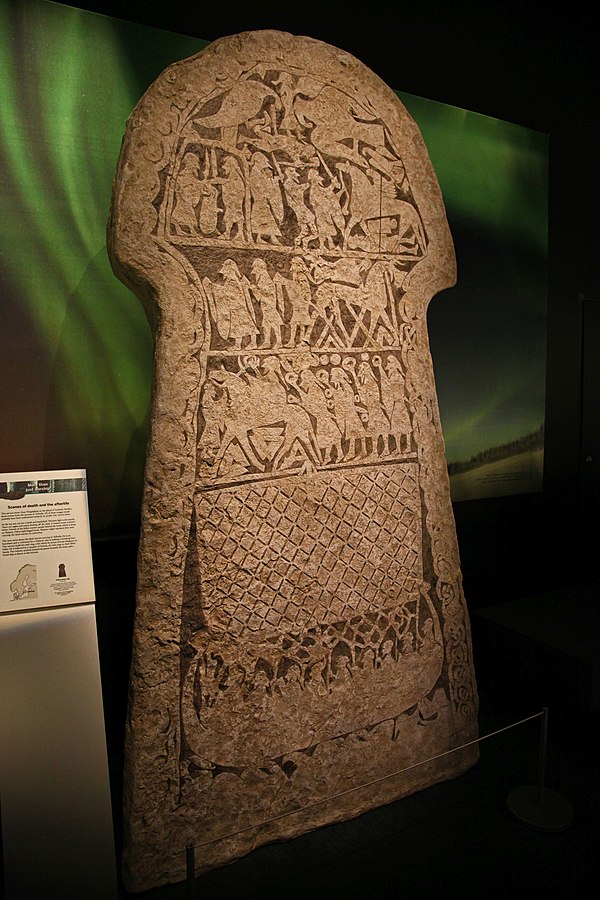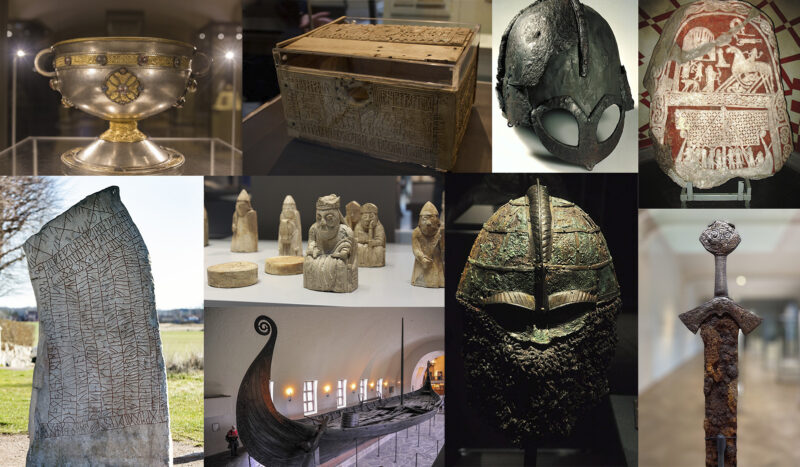The Viking Age, spanning from the late 8th to the early 11th century, remains one of the most fascinating periods in history, marked by the expansion of Norse peoples across Europe and beyond.
The Vikings, often remembered for their roles as fearsome raiders and warriors, were also skilled craftsmen, traders, and explorers whose cultural and artistic legacy has endured through the centuries.
The artifacts left behind, ranging from magnificent ships to intricate jewelry, not only showcase the Vikings’ remarkable craftsmanship but also offer insight into their daily lives, beliefs, and societal structures. In exploring the top 20 Viking artifacts, we delve into the heart of Norse culture, uncovering the stories and significance behind these historical treasures.
1. Oseberg Ship
The Oseberg Ship, discovered in a large burial mound at the Oseberg farm near Tønsberg in Vestfold, Norway, in 1904, is one of the most magnificent finds from the Viking Age. Dated to 834 AD, the ship was used as a burial vessel for two women of high status, illustrating the importance of women in Viking society.

The ship itself is a masterpiece of Viking craftsmanship, adorned with intricate carvings of animals and mythical creatures, showcasing the Vikings’ advanced woodworking skills. The burial also contained a rich collection of wooden objects, textiles, and other grave goods, providing invaluable insights into Viking life and beliefs.
2. Gjermundbu Helmet
Found in a grave in Gjermundbu, Norway, in 1943, the Gjermundbu Helmet is the only known example of a complete Viking helmet in existence. Dating from the 10th century, it features a rounded iron cap and a guard around the eyes and nose, offering protection in battle.

This helmet’s discovery has been crucial for understanding Viking armor, debunking the myth of horned Viking helmets popularized in modern culture. It provides a rare glimpse into the realities of Viking warfare and personal protection methods.
3. Roskilde 6
Unearthed during an expansion of the Roskilde Ship Museum in Denmark in 1996, Roskilde 6 remains the largest Viking ship ever discovered, with a length of over 36 meters. Radiocarbon dating places its construction in the early 11th century, suggesting it played a significant role in Viking expansion and naval power.

The ship’s size indicates it was built for warfare and could carry a large crew, emphasizing the Vikings’ engineering prowess and their strategic use of ships for exploration, trade, and military conquests.
4. Lewis Chessmen
The Lewis Chessmen were discovered in 1831 on the Isle of Lewis in the Outer Hebrides, Scotland. These chess pieces, carved from walrus ivory and whale teeth, date back to the 12th century and are believed to have been made in Norway.

Comprising kings, queens, bishops, knights, rooks, and pawns, the chessmen highlight the cultural and social aspects of the Norse world, including the game of chess, which was popular among the elite. Their discovery has provided significant insight into the artistry and daily life of the Viking Age.
5. Hoen Hoard
The Hoen Hoard was discovered in 1834 in Buskerud, Norway, and is one of the most spectacular gold finds from the Viking Age. The hoard includes a large gold collar, rings, and other pieces of jewelry, totaling over 2.5 kilograms of gold.

The craftsmanship and style of the artifacts suggest they were made in the 9th century, reflecting the wealth, extensive trade networks, and the importance of gold as a symbol of power and prestige among the Vikings.
6. The Rök Runestone
Located in Östergötland, Sweden, the Rök Runestone is famed for its lengthy runic inscription, which is the most extensive known. Erected in the 9th century, the stone’s intricate text weaves a complex narrative that combines references to heroic acts, historical events, and Norse mythology.

Scholars have debated its exact meaning for years, but it clearly demonstrates the Vikings’ sophisticated use of runic script for memorializing the dead, storytelling, and possibly magical or protective purposes.
7. Mjölnir Pendants
Mjölnir pendants, symbolizing Thor’s hammer, were widely used throughout the Viking world as amulets for protection and power. Found across Scandinavia, England, and other areas of Viking influence, these pendants vary in design but consistently represent the hammer of Thor, a major god in Norse mythology.

Their widespread use from the 9th to 11th centuries underscores the importance of religion and mythology in Viking culture, as well as the artistic diversity in the creation of these amulets.
8. The Jelling Stones
The Jelling stones, erected by King Gorm the Old and his son Harald Bluetooth in the 10th century in Jelling, Denmark, are monumental runestones that mark the transition of the Danes from paganism to Christianity.

The larger of the two stones features a depiction of Christ, signifying one of the first known representations of Jesus in Scandinavia. These stones not only reflect the shift in religious beliefs but also serve as a testament to the power and legacy of the Danish kings of the Viking Age.
9. The Valsgärde Helmets
Discovered in the Valsgärde boat graves in Uppsala, Sweden, these helmets date from the 7th to the 11th centuries. They are characterized by their ornate designs, including decorative metalwork and animal motifs, reflecting the influence of various artistic traditions within the Viking world.

The helmets underscore the importance of the warrior class in Viking society and provide insights into the evolution of military equipment and ceremonial items over several centuries.
10. The Birka Crucifix
The small silver crucifix found in Birka, a major Viking Age trade center in Sweden, indicates the early presence of Christianity among the Viking population. Dated to the mid-9th century, this artifact is one of the earliest Christian symbols discovered in Scandinavia, suggesting a complex interaction between pagan beliefs and the gradual introduction of Christianity.

Its discovery in a prominent trading center like Birka highlights the role of trade in spreading religious ideas and cultural exchange.
11. The Ship Burial at Sutton Hoo
Although not a Viking artifact, the early 7th-century ship burial at Sutton Hoo, in Suffolk, England, contains artifacts that reflect the influence of Norse culture across the North Sea.

The burial, likely of an Anglo-Saxon king, includes a ship filled with treasures such as weapons, armor, and silverware that demonstrate the interconnectedness of European societies during the early medieval period.
The craftsmanship and designs found at Sutton Hoo show the cross-cultural influences and the shared artistic and material culture of the time.
12. The Langeid Sword
The Langeid Sword, discovered in a grave in Setesdal, Norway, is a striking example of Viking Age weaponry, dating back to the late 10th or early 11th century. The sword’s hilt is decorated with gold, silver, and copper alloy, and it bears an inscription that may link it to England, suggesting the broad reach of Viking raids and trade.

This artifact highlights the importance of swords as symbols of status and power among the Vikings, as well as their skill in metalwork and ornamentation.
13. The Ardagh Chalice
While not a Viking artifact, the Ardagh Chalice, found in County Limerick, Ireland, represents the high skill in metalwork of the period, often contemporaneous with Viking settlements and raids in Ireland. This 8th-century work of art is made of silver, gold, and bronze, and is considered one of the finest examples of early medieval ecclesiastical metalwork in Europe.

Its intricate design and craftsmanship influenced by both Irish and Norse artistry, reflects the complex cultural interactions between Vikings and the native populations of the British Isles.
14. The Viking Hoard from Cuerdale
Discovered in 1840 near Preston, Lancashire, England, the Cuerdale Hoard is one of the largest Viking silver treasures ever found. It consists of over 8,600 items, including silver coins, ingots, and jewelry, believed to have been buried in the late 9th century.

The hoard’s composition suggests it was not only a wealth deposit but also a strategic reserve for the Viking army, offering insights into the economic practices, trade networks, and military planning of the Viking Age.
15. The Tjängvide Image Stone
The Tjängvide Image Stone, found on the island of Gotland, Sweden, is a notable artifact for its detailed depiction of Norse mythology, including an image that is often interpreted as the god Odin being welcomed by a Valkyrie into the afterlife.

Dating from the 8th century, this stone is a valuable source of information on Viking beliefs, artistic expression, and the importance of storytelling in Norse culture. The motifs and scenes carved into the stone are key to understanding the Vikings’ worldview and their conceptions of life, death, and the afterlife.
16. The Borre-style Harness Mounts
Named after a find at Borre mound cemetery in Vestfold, Norway, Borre-style art is characterized by its intricate animal and knotwork patterns, dating from the late 9th to 10th centuries.

The style is evident in various metalwork artifacts, including harness mounts, which were used both for practical purposes in horse equipment and as decorative items, showcasing the Vikings’ appreciation for art in everyday objects. This style spread across Viking territories, reflecting the interconnectedness of their culture and the spread of artistic trends throughout the Norse world.
17. The Franks Casket
The Franks Casket is an intricately carved whalebone chest from the early 8th century, found in France but of Anglo-Saxon origin. It features runic inscriptions and imagery from Christian, Roman, Germanic, and Norse mythology, presenting a unique blend of cultural influences.

The casket illustrates the syncretism of Viking Age Europe, where various beliefs and artistic styles coexisted and influenced each other. It is a testament to the complex interactions between the Vikings and the cultures they came into contact with.
18. The Tune Ship
Discovered in 1867 in Østfold, Norway, the Tune Ship is another significant example of Viking shipbuilding, dating to the late 9th century. Although not as well-preserved as the Oseberg or Gokstad ships, the Tune Ship provides valuable insights into the design and construction of Viking vessels, which were crucial to their expeditions across the seas.

The ship’s remains highlight the Vikings’ advanced naval technology and their ability to navigate vast distances, facilitating their roles as traders, raiders, and explorers.
19. The Gotland Picture Stones
The Gotland Picture Stones are a collection of carved stones from the island of Gotland, Sweden, dating from the 5th to the 11th centuries. These stones feature a wide range of motifs, including ships, warriors, animals, and scenes from Norse mythology, providing a rich visual narrative of Viking life and beliefs.

The variety of imagery on the picture stones offers a glimpse into the daily life, religious practices, and societal values of the Vikings, making them an invaluable resource for understanding Norse culture.
20. The Hammer of Thor (Mjölnir) from Købelev
The Købelev Runic-Thor’s Hammer, discovered on the island of Lolland, Denmark, in 2014, stands out for its runic inscription that reads, “This is a hammer.” Dating from the 10th century, it is one of the few Thor’s hammers found that directly references its association with the Norse god Thor.
This artifact not only reflects the religious beliefs of the Viking Age but also illustrates the use of runes for inscriptions, which were not solely used for monumental stones but also for personal items, imbuing them with meaning and protection.
Top Viking Artifacts Conclusion
The artifacts discussed above represent just a glimpse into the rich tapestry of Viking life and culture. From the awe-inspiring ships that carried them across the known world to the personal items that adorned their bodies and homes, each artifact tells a part of the larger story of the Norse people.
These objects serve as a bridge to the past, offering us a tangible connection to the lives of individuals who lived over a millennium ago. Through the study and preservation of these artifacts, we gain not only a deeper understanding of Viking craftsmanship and aesthetic sensibilities but also of their social structures, religious beliefs, and the interactions that they had with the wider world.
As we continue to unearth and analyze the remnants of the Viking Age, we keep unraveling the complex narrative of a people who, far from being mere raiders, were influential shapers of the medieval world.
**Please note that this post may contain affiliate links. When booking through one of our links, we earn a small kickback at no extra cost to you and it’s a big help to keep the site up and running.









